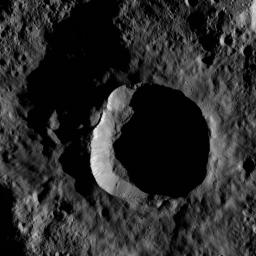
|
Dawn LAMO Image 52
- Click the image above for a larger view
- Full-Res JPEG (1024 x 1024) (137.9 kB)
- Full-Res TIFF (1024 x 1024) (863.8 kB)
Caption:
This view from NASA's Dawn spacecraft shows an impact site at high southern latitude on Ceres. A smooth blanket of ejecta surrounds the crater. Many boulders can be seen around the crater's rim and on the sunlit part of its floor.
The view is centered at approximately 68 degrees south latitude, 78 degrees east longitude.
Dawn acquired this image on Feb. 7, 2016, from its low-altitude mapping orbit, at a distance of about 240 miles (385 kilometers) from the surface. The image resolution is 120 feet (35 meters) per pixel.
Background Info:
Dawn's mission is managed by JPL for NASA's Science Mission Directorate in Washington. Dawn is a project of the directorate's Discovery Program, managed by NASA's Marshall Space Flight Center in Huntsville, Alabama. UCLA is responsible for overall Dawn mission science. Orbital ATK, Inc., in Dulles, Virginia, designed and built the spacecraft. The German Aerospace Center, the Max Planck Institute for Solar System Research, the Italian Space Agency and the Italian National Astrophysical Institute are international partners on the mission team. For a complete list of acknowledgments, see http://dawn.jpl.nasa.gov/mission .
For more information about the Dawn mission, visit http://dawn.jpl.nasa.gov .
Cataloging Keywords:
| Name | Value | Additional Values |
|---|---|---|
| Target | 1 Ceres | |
| System | Main Belt | |
| Target Type | Dwarf Planet | Asteroid |
| Mission | Dawn | |
| Instrument Host | Dawn | |
| Host Type | Orbiter | |
| Instrument | Framing Camera (FC) | |
| Detector | ||
| Extra Keywords | Crater, Grayscale, Impact | |
| Acquisition Date | ||
| Release Date | 2016-03-24 | |
| Date in Caption | 2016-02-07 | |
| Image Credit | NASA/JPL-Caltech/UCLA/MPS/DLR/IDA | |
| Source | photojournal.jpl.nasa.gov/catalog/PIA20407 | |
| Identifier | PIA20407 | |
